traction control FORD FUSION HYBRID 2014 User Guide
[x] Cancel search | Manufacturer: FORD, Model Year: 2014, Model line: FUSION HYBRID, Model: FORD FUSION HYBRID 2014Pages: 473, PDF Size: 5.93 MB
Page 242 of 473

Protected componentsFuse amp ratingFuse or relay number
Not used (spare)
10A 2
8
Not used (spare)
10A 2
9
Keypad, Cell phone passport module
(Fusion Energi)5A 2
10
Not used (spare)
5A 2
11
Climate control, Gear shift
7.5A 2
12
Steering wheel column, Cluster, Datalink
logic7.5A 2
13
Traction battery control module (Hybrid)
10A 2
14
Datalink/Gateway module
10A 2
15
Trunk release
15A 1
16
Not used (spare)
5A 2
17
Ignition, Push button stop/start
5A 2
18
Passenger airbag disabled indicator,
Transmission range5A 2
19
Not used (spare)
5A 2
20
Humidity and in–car temperature (Hybrid)
5A 2
21
Occupant classification sensor
5A 2
22
Delayed Accessory (Power inverter logic,
Moonroof logic)10A 1
23
Central lock/unlock
30A 1
24
Driver door (window, mirror)
30A 1
25
Front passenger door (window, mirror)
30A 1
26
Moonroof
30A 1
27
Sony amplifier
20A 1
28
239Fuses
Page 276 of 473

TIRE CARE
Information About Uniform
Tire Quality Grading E142542
Tire Quality Grades apply to new
pneumatic passenger car tires.
The Quality grades can be found
where applicable on the tire
sidewall between tread shoulder
and maximum section width. For
example: Treadwear 200
Traction AA Temperature A .
These Tire Quality Grades are
determined by standards that the
United States Department of
Transportation has set.
Tire Quality Grades apply to new
pneumatic passenger car tires.
They do not apply to deep tread,
winter-type snow tires,
space-saver or temporary use
spare tires, light truck or LT type
tires, tires with nominal rim
diameters of 10 to 12 inches or
limited production tires as defined
in Title 49 Code of Federal
Regulations Part 575.104 (c)(2). U.S. Department of
Transportation Tire quality
grades: The U.S. Department of
Transportation requires Ford
Motor Company to give you the
following information about tire
grades exactly as the government
has written it.
Treadwear
The treadwear grade is a
comparative rating based on the
wear rate of the tire when tested
under controlled conditions on a
specified government test course.
For example, a tire graded 150
would wear 1½ times as well on
the government course as a tire
graded 100. The relative
performance of tires depends
upon the actual conditions of their
use, however, and may depart
significantly from the norm due to
variations in driving habits, service
practices, and differences in road
characteristics and climate.
Traction AA A B C
WARNING
The traction grade assigned
to this tire is based on
straight-ahead braking traction
tests, and does not include
acceleration, cornering,
hydroplaning or peak traction
characteristics.
273Wheels and Tires
Page 277 of 473
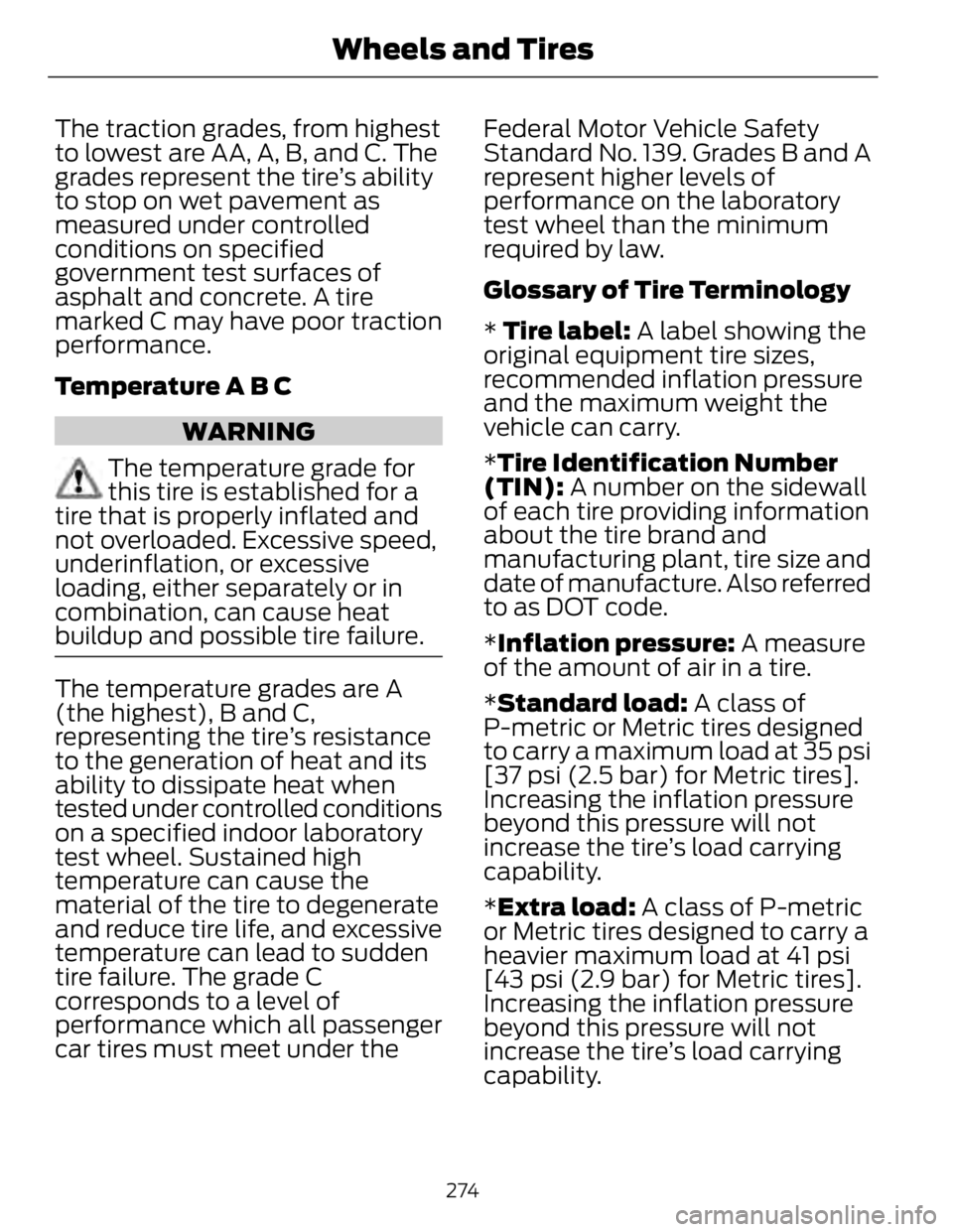
The traction grades, from highest
to lowest are AA, A, B, and C. The
grades represent the tire’s ability
to stop on wet pavement as
measured under controlled
conditions on specified
government test surfaces of
asphalt and concrete. A tire
marked C may have poor traction
performance.
Temperature A B C
WARNING
The temperature grade for
this tire is established for a
tire that is properly inflated and
not overloaded. Excessive speed,
underinflation, or excessive
loading, either separately or in
combination, can cause heat
buildup and possible tire failure.
The temperature grades are A
(the highest), B and C,
representing the tire’s resistance
to the generation of heat and its
ability to dissipate heat when
tested under controlled conditions
on a specified indoor laboratory
test wheel. Sustained high
temperature can cause the
material of the tire to degenerate
and reduce tire life, and excessive
temperature can lead to sudden
tire failure. The grade C
corresponds to a level of
performance which all passenger
car tires must meet under the Federal Motor Vehicle Safety
Standard No. 139. Grades B and A
represent higher levels of
performance on the laboratory
test wheel than the minimum
required by law.
Glossary of Tire Terminology
* Tire label: A label showing the
original equipment tire sizes,
recommended inflation pressure
and the maximum weight the
vehicle can carry.
* Tire Identification Number
(TIN): A number on the sidewall
of each tire providing information
about the tire brand and
manufacturing plant, tire size and
date of manufacture. Also referred
to as DOT code.
* Inflation pressure: A measure
of the amount of air in a tire.
* Standard load: A class of
P-metric or Metric tires designed
to carry a maximum load at 35 psi
[37 psi (2.5 bar) for Metric tires].
Increasing the inflation pressure
beyond this pressure will not
increase the tire’s load carrying
capability.
* Extra load: A class of P-metric
or Metric tires designed to carry a
heavier maximum load at 41 psi
[43 psi (2.9 bar) for Metric tires].
Increasing the inflation pressure
beyond this pressure will not
increase the tire’s load carrying
capability.
274Wheels and Tires
Page 280 of 473

mph ( km/h)Letter
rating
168 mph (270 km/h)W
186 mph (299 km/h)Y
Note: For tires with a maximum
speed capability over 149 mph
(240 km/h), tire manufacturers
sometimes use the letters ZR. For
those with a maximum speed
capability over 186 mph (299
km/h), tire manufacturers always
use the letters ZR.
H. U.S. DOT Tire Identification
Number (TIN): This begins with
the letters DOT and indicates that
the tire meets all federal
standards. The next two numbers
or letters are the plant code
designating where it was
manufactured, the next two are
the tire size code and the last four
numbers represent the week and
year the tire was built. For
example, the numbers 317 mean
the 31st week of 1997. After 2000
the numbers go to four digits. For
example, 2501 means the 25th
week of 2001. The numbers in
between are identification codes
used for traceability. This
information is used to contact
customers if a tire defect requires
a recall.
I. M+S or M/S: Mud and Snow, or
AT : All Terrain, or
AS: All Season. J. Tire Ply Composition and
Material Used: Indicates the
number of plies or the number of
layers of rubber-coated fabric in
the tire tread and sidewall. Tire
manufacturers also must indicate
the ply materials in the tire and the
sidewall, which include steel,
nylon, polyester, and others.
K. Maximum Load: Indicates the
maximum load in kilograms and
pounds that can be carried by the
tire. See the Safety Compliance
Certification Label (affixed to
either the door hinge pillar,
door-latch post, or the door edge
that meets the door-latch post,
next to the driver's seating
position), for the correct tire
pressure for your vehicle.
L. Treadwear, Traction and
Temperature Grades:
* Treadwear The treadwear
grade is a comparative rating
based on the wear rate of the tire
when tested under controlled
conditions on a specified
government test course. For
example, a tire graded 150 would
wear one and one-half times as
well on the government course as
a tire graded 100.
277Wheels and Tires
Page 281 of 473
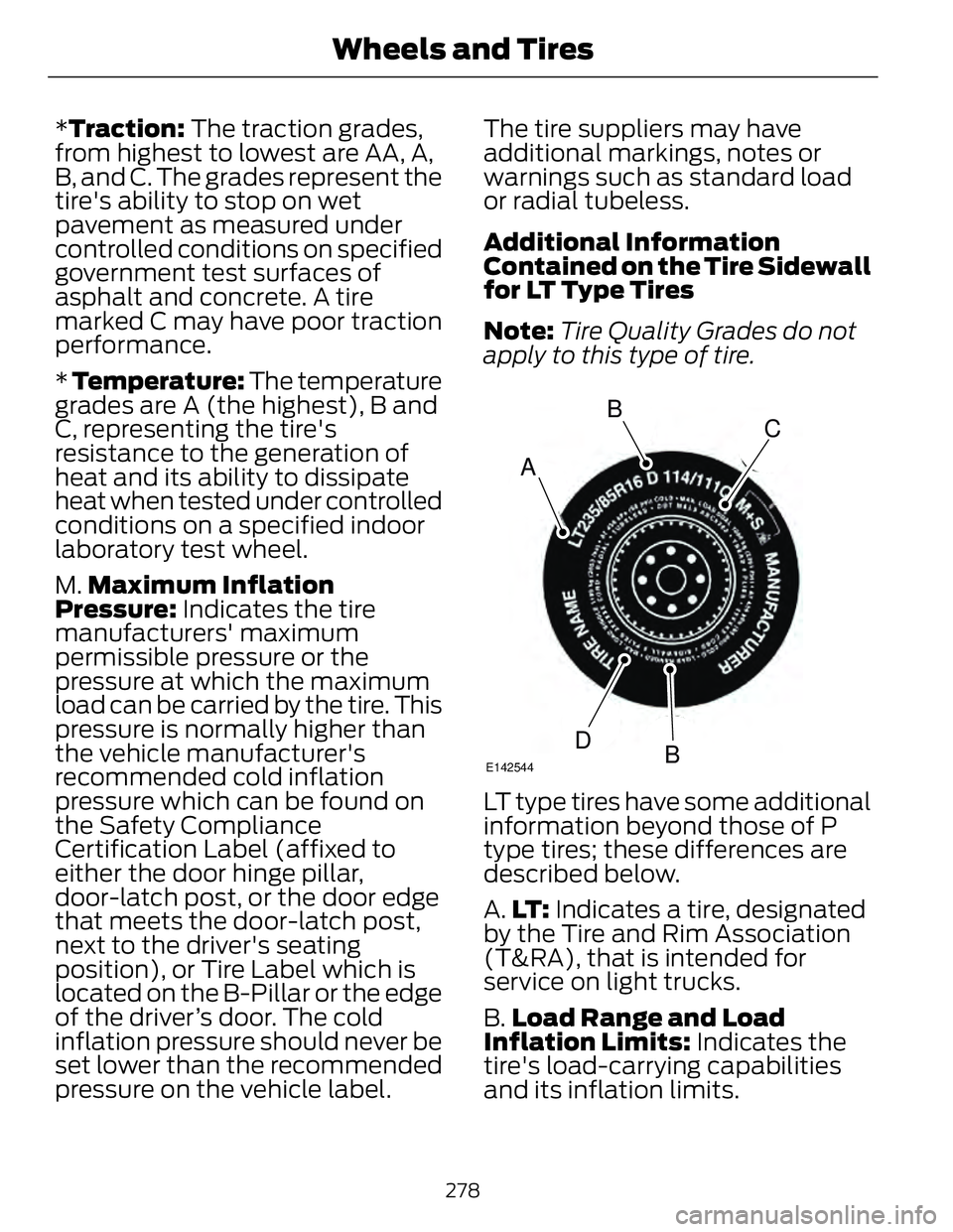
* Traction: The traction grades,
from highest to lowest are AA, A,
B, and C. The grades represent the
tire's ability to stop on wet
pavement as measured under
controlled conditions on specified
government test surfaces of
asphalt and concrete. A tire
marked C may have poor traction
performance.
* Temperature: The temperature
grades are A (the highest), B and
C, representing the tire's
resistance to the generation of
heat and its ability to dissipate
heat when tested under controlled
conditions on a specified indoor
laboratory test wheel.
M. Maximum Inflation
Pressure: Indicates the tire
manufacturers' maximum
permissible pressure or the
pressure at which the maximum
load can be carried by the tire. This
pressure is normally higher than
the vehicle manufacturer's
recommended cold inflation
pressure which can be found on
the Safety Compliance
Certification Label (affixed to
either the door hinge pillar,
door-latch post, or the door edge
that meets the door-latch post,
next to the driver's seating
position), or Tire Label which is
located on the B-Pillar or the edge
of the driver’s door. The cold
inflation pressure should never be
set lower than the recommended
pressure on the vehicle label. The tire suppliers may have
additional markings, notes or
warnings such as standard load
or radial tubeless.
Additional Information
Contained on the Tire Sidewall
for LT Type Tires
Note: Tire Quality Grades do not
apply to this type of tire.
A B
C
BD E142544
LT type tires have some additional
information beyond those of P
type tires; these differences are
described below.
A. LT : Indicates a tire, designated
by the Tire and Rim Association
(T&RA), that is intended for
service on light trucks.
B. Load Range and Load
Inflation Limits: Indicates the
tire's load-carrying capabilities
and its inflation limits.
278Wheels and Tires
Page 294 of 473
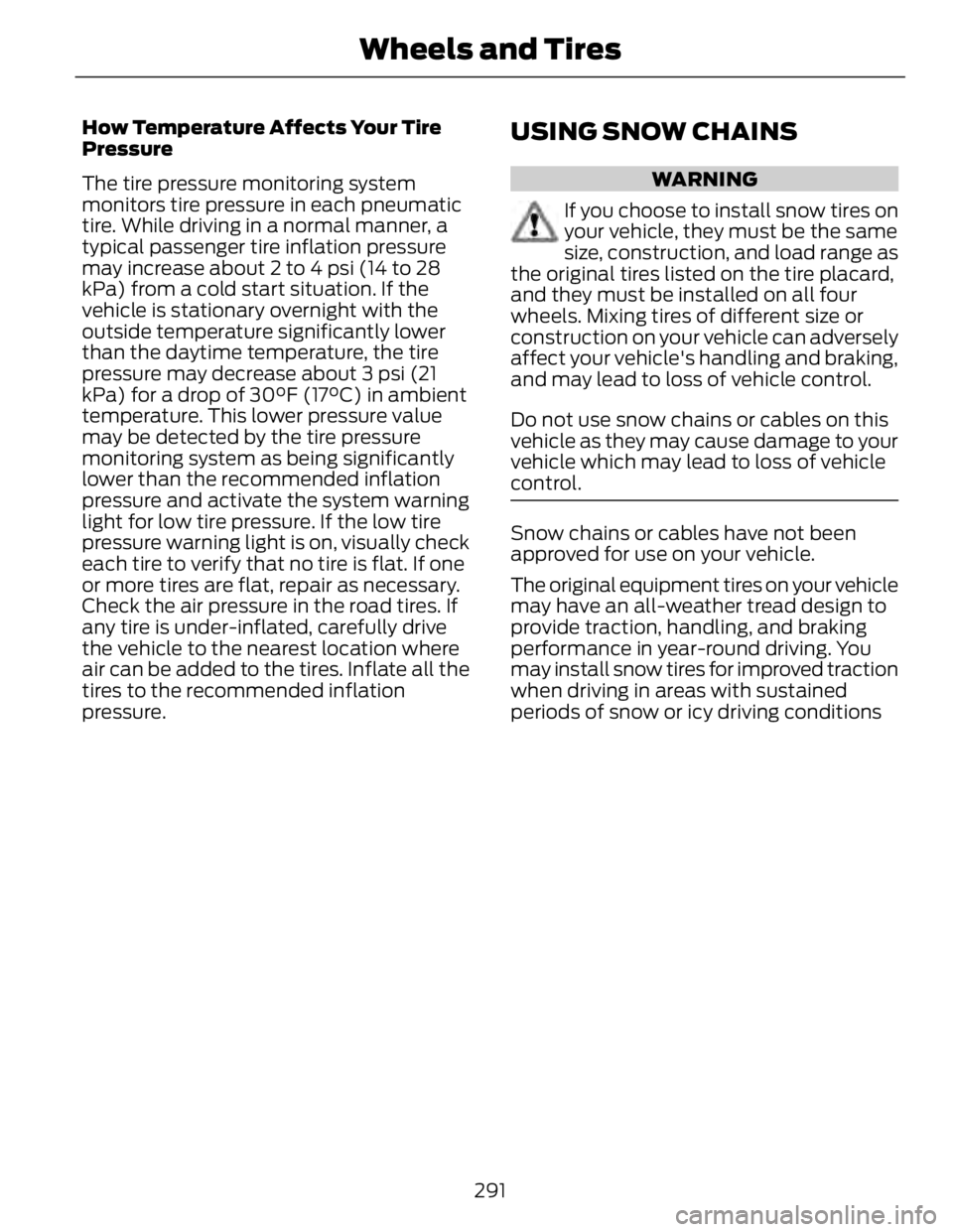
How Temperature Affects Your Tire
Pressure
The tire pressure monitoring system
monitors tire pressure in each pneumatic
tire. While driving in a normal manner, a
typical passenger tire inflation pressure
may increase about 2 to 4 psi (14 to 28
kPa) from a cold start situation. If the
vehicle is stationary overnight with the
outside temperature significantly lower
than the daytime temperature, the tire
pressure may decrease about 3 psi (21
kPa) for a drop of 30°F (17°C) in ambient
temperature. This lower pressure value
may be detected by the tire pressure
monitoring system as being significantly
lower than the recommended inflation
pressure and activate the system warning
light for low tire pressure. If the low tire
pressure warning light is on, visually check
each tire to verify that no tire is flat. If one
or more tires are flat, repair as necessary.
Check the air pressure in the road tires. If
any tire is under-inflated, carefully drive
the vehicle to the nearest location where
air can be added to the tires. Inflate all the
tires to the recommended inflation
pressure. USING SNOW CHAINS WARNING
If you choose to install snow tires on
your vehicle, they must be the same
size, construction, and load range as
the original tires listed on the tire placard,
and they must be installed on all four
wheels. Mixing tires of different size or
construction on your vehicle can adversely
affect your vehicle's handling and braking,
and may lead to loss of vehicle control.
Do not use snow chains or cables on this
vehicle as they may cause damage to your
vehicle which may lead to loss of vehicle
control.
Snow chains or cables have not been
approved for use on your vehicle.
The original equipment tires on your vehicle
may have an all-weather tread design to
provide traction, handling, and braking
performance in year-round driving. You
may install snow tires for improved traction
when driving in areas with sustained
periods of snow or icy driving conditions
291Wheels and Tires
Page 437 of 473

WARNING
Operating certain parts of this
system while driving can distract
your attention away from the road,
and possibly cause an accident or other
serious consequences. Do not change
system settings or enter data non-verbally
(using your hands) while driving. Stop the
vehicle in a safe and legal manner before
attempting these operations. This is
important since while setting up or
changing some functions you might be
required to distract your attention away
from the road and remove your hands from
the wheel.
General Operation
Voice Command Control: Functions
within the Windows Automotive-based
system may be accomplished using only
voice commands. Using voice commands
while driving allows you to operate the
system without removing your hands from
the wheel.
Prolonged Views of Screen: Do not
access any function requiring a prolonged
view of the screen while you are driving.
Pull over in a safe and legal manner before
attempting to access a function of the
system requiring prolonged attention. Even
occasional short scans to the screen may
be hazardous if your attention has been
diverted away from your driving task at a
critical time.
Volume Setting: Do not raise the volume
excessively. Keep the volume at a level
where you can still hear outside traffic and
emergency signals while driving. Driving
while unable to hear these sounds could
cause an accident. Use of Speech Recognition Functions:
Speech recognition software is inherently
a statistical process which is subject to
errors. It is your responsibility to monitor
any speech recognition functions included
in the system and address any errors.
Navigation Features: Any navigation
features included in the system are
intended to provide turn by turn
instructions to get you to a desired
destination. Please make certain all
persons using this system carefully read
and follow instructions and safety
information fully.
Distraction Hazard: Any navigation
features may require manual (non-verbal)
setup. Attempting to perform such set-up
or insert data while driving can seriously
distract your attention and could cause an
accident or other serious consequences.
Stop the vehicle in a safe and legal manner
before attempting these operations.
Let Your Judgment Prevail: Any
navigation features are provided only as
an aid. Make your driving decisions based
on your observations of local conditions
and existing traffic regulations. Any such
feature is not a substitute for your personal
judgment. Any route suggestions made by
this system should never replace any local
traffic regulations or your personal
judgment or knowledge of safe driving
practices.
Route Safety: Do not follow the route
suggestions if doing so would result in an
unsafe or illegal maneuver, if you would be
placed in an unsafe situation, or if you
would be directed into an area that you
consider unsafe. The driver is ultimately
responsible for the safe operation of the
vehicle and therefore, must evaluate
whether it is safe to follow the suggested
directions.
434Appendices
Page 468 of 473
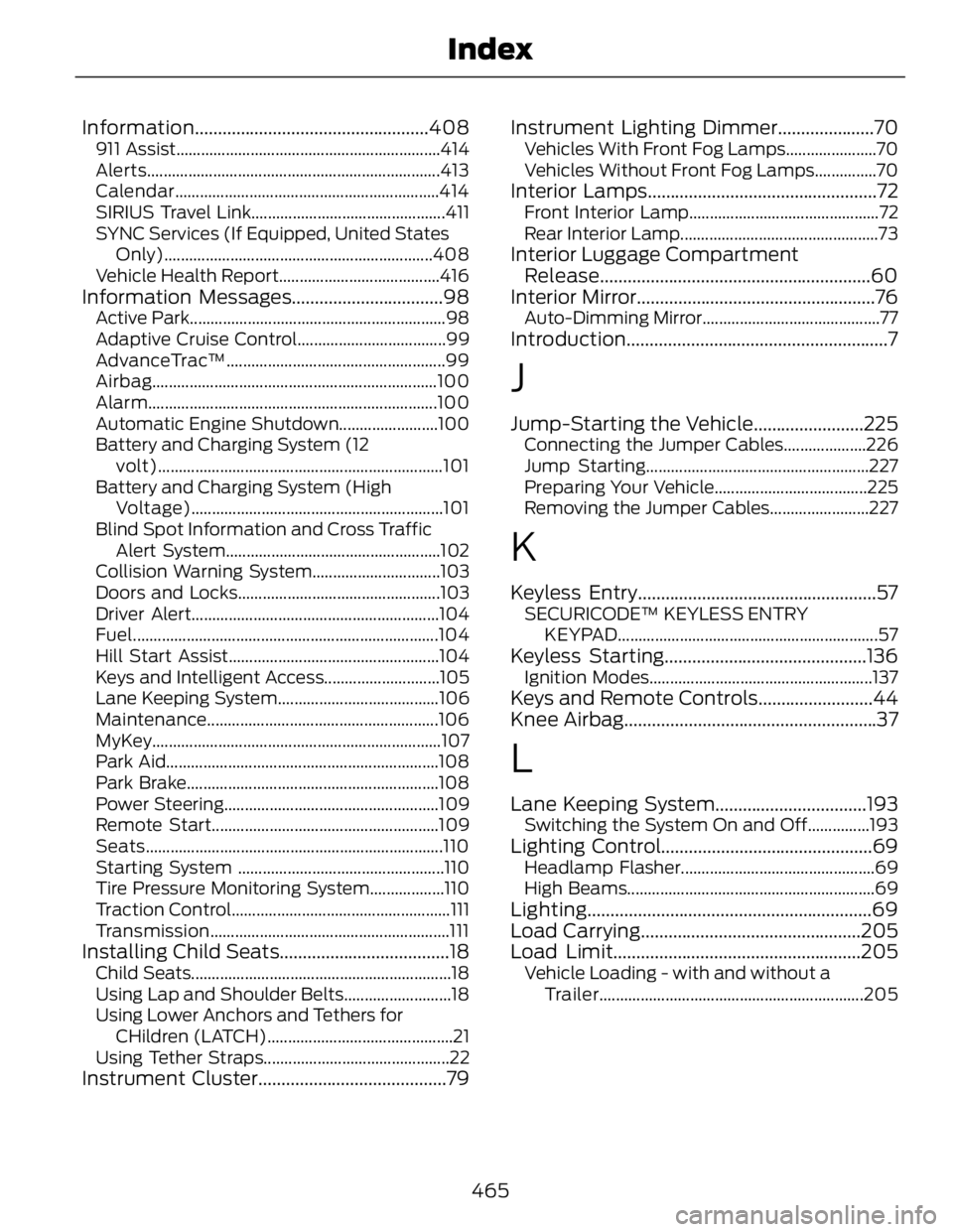
Information ...................................................408911 Assist................................................................414
Alerts.......................................................................413
Calendar ................................................................414
SIRIUS Travel Link...............................................411
SYNC Services (If Equipped, United States
Only).................................................................408
Vehicle Health Report.......................................416
Information Messages.................................98 Active Park..............................................................98
Adaptive Cruise Control....................................99
AdvanceTrac™.....................................................99
Airbag .....................................................................100
Alarm......................................................................100
Automatic Engine Shutdown........................100
Battery and Charging System (12
volt).....................................................................101
Battery and Charging System (High
Voltage).............................................................101
Blind Spot Information and Cross Traffic
Alert System....................................................102
Collision Warning System...............................103
Doors and Locks.................................................103
Driver Alert............................................................104
Fuel ..........................................................................104
Hill Start Assist...................................................104
Keys and Intelligent Access............................105
Lane Keeping System.......................................106
Maintenance ........................................................ 106
MyKey......................................................................107
Park Aid..................................................................108
Park Brake.............................................................108
Power Steering....................................................109
Remote Start.......................................................109
Seats........................................................................110
Starting System ..................................................110
Tire Pressure Monitoring System..................110
Traction Control.....................................................111
Transmission ..........................................................111
Installing Child Seats.....................................18 Child Seats...............................................................18
Using Lap and Shoulder Belts..........................18
Using Lower Anchors and Tethers for
CHildren (LATCH).............................................21
Using Tether Straps.............................................22
Instrument Cluster.........................................79 Instrument Lighting Dimmer.....................70 Vehicles With Front Fog Lamps......................70
Vehicles Without Front Fog Lamps...............70
Interior Lamps..................................................72 Front Interior Lamp..............................................72
Rear Interior Lamp................................................73
Interior Luggage Compartment
Release...........................................................60
Interior Mirror....................................................76 Auto-Dimming Mirror...........................................77
Introduction .........................................................7
J Jump-Starting the Vehicle........................225 Connecting the Jumper Cables....................226
Jump Starting......................................................227
Preparing Your Vehicle.....................................225
Removing the Jumper Cables........................227
K Keyless Entry....................................................57 SECURICODE™ KEYLESS ENTRY
KEYPAD ...............................................................57
Keyless Starting............................................136 Ignition Modes......................................................137
Keys and Remote Controls.........................44
Knee Airbag.......................................................37
L Lane Keeping System.................................193 Switching the System On and Off...............193
Lighting Control..............................................69 Headlamp Flasher...............................................69
High Beams............................................................69
Lighting ..............................................................69
Load Carrying................................................205
Load Limit......................................................205 Vehicle Loading - with and without a
Trailer................................................................205
465Index
Page 471 of 473

Satellite Radio...............................................310 Satellite Radio Electronic Serial Number
(ESN)...................................................................311
Satellite Radio Reception Factors...............310
SIRIUS® Satellite Radio Service..................310
Trouble shooting ................................................... 311
Scheduled Maintenance Record...........454
Scheduled Maintenance..........................444
Seats...................................................................121
Security ...............................................................61
Settings...........................................................364 Clock .......................................................................365
Display ...................................................................365
Settings ..................................................................367
Sound ....................................................................366
Vehicle ...................................................................366
Side Airbags.....................................................40
Side Curtain Airbags......................................41
Sitting in the Correct Position...................121
Snow Chains See: Using Snow Chains..................................291
Special Notices................................................12 New Vehicle Limited Warranty.........................12
Special Instructions..............................................12
Special Operating Conditions Scheduled
Maintenance ...............................................451Exceptions ............................................................453
Speed Control See: Cruise Control............................................185
Stability Control.............................................175 Principle of Operation.......................................175
Starter Switch See: Ignition Switch...........................................136
Starting a Gasoline Engine........................137 Automatic Shutdown.......................................138
Guarding Against Exhaust Fumes...............140
Important Ventilating Information..............140
Switching Off the Vehicle When It Is
Moving...............................................................139
Switching Off the Vehicle When It Is
Stationary .........................................................139
Vehicles with an Ignition Key..........................137
Vehicles with Keyless Start.............................137
Starting and Stopping the Engine..........136
General Information..........................................136
Steering ............................................................ 201
Electric Power Steering....................................201
Steering Wheel...............................................64 Storage Compartments.............................135
Sunroof See: Moonroof........................................................77
Sun Visors..........................................................77 Illuminated Vanity Mirror....................................77
Supplementary Restraints System.........35 Principle of Operation.........................................35
Symbols Glossary.............................................7
SYNC™ Applications and
Services ........................................................335911 Assist...............................................................335
SYNC AppLink.....................................................341
SYNC Services: Traffic, Directions &
Information (TDI).........................................338
Vehicle Health Report......................................337
SYNC™............................................................319 General Information..........................................319
SYNC™ Troubleshooting.........................350
T Technical Specifications See: Capacities and Specifications............293
Temporary Mobility Kit...............................267 First Stage: Reinflating the Tire with Sealing
Compound and Air.......................................269
General Information..........................................267
Second Stage: Checking Tire
Pressure ............................................................270
Tips for Use of the Kit......................................268
What to do after the Tire has been
Sealed.................................................................271
What to do when a Tire Is Punctured........268
The Better Business Bureau (BBB) Auto
Line Program (U.S. Only).......................220
Tire Care...........................................................273 Glossary of Tire Terminology.........................274
Information About Uniform Tire Quality
Grading ..............................................................273
Information Contained on the Tire
Sidewall............................................................275
Temperature A B C.............................................274
Traction AA A B C...............................................273
Treadwear.............................................................273
Tire Inflation When Punctured
See: Temporary Mobility Kit...........................267
468Index
Page 472 of 473
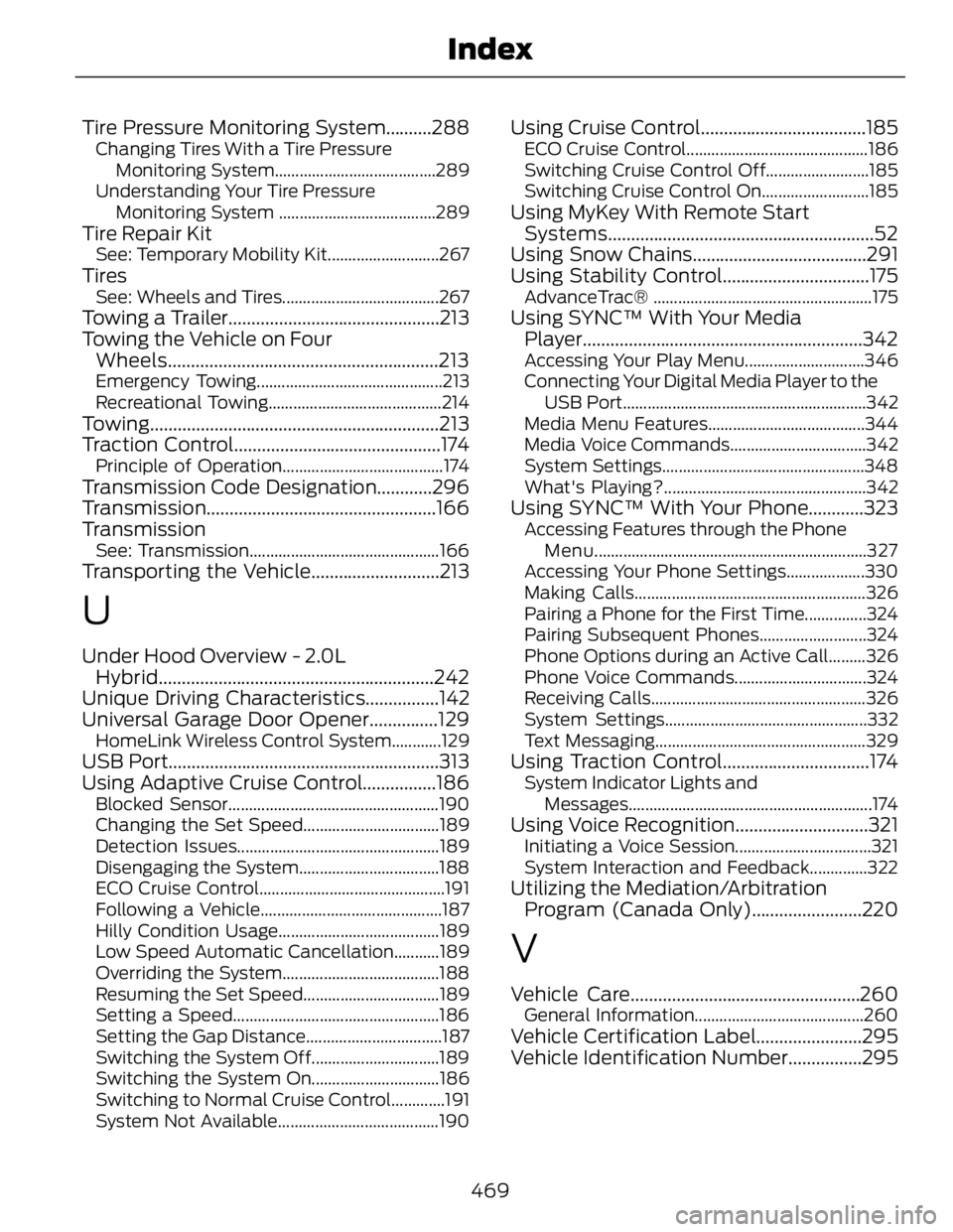
Tire Pressure Monitoring System..........288 Changing Tires With a Tire Pressure
Monitoring System.......................................289
Understanding Your Tire Pressure
Monitoring System ......................................289
Tire Repair Kit See: Temporary Mobility Kit...........................267
Tires See: Wheels and Tires......................................267
Towing a Trailer..............................................213
Towing the Vehicle on Four
Wheels...........................................................213 Emergency Towing.............................................213
Recreational Towing..........................................214
Towing ............................................................... 213
Traction Control.............................................174 Principle of Operation.......................................174
Transmission Code Designation............296
Transmission ..................................................166
Transmission See: Transmission..............................................166
Transporting the Vehicle............................213
U Under Hood Overview - 2.0L
Hybrid............................................................242
Unique Driving Characteristics................142
Universal Garage Door Opener...............129 HomeLink Wireless Control System............129
USB Port...........................................................313
Using Adaptive Cruise Control................186 Blocked Sensor...................................................190
Changing the Set Speed.................................189
Detection Issues.................................................189
Disengaging the System..................................188
ECO Cruise Control.............................................191
Following a Vehicle............................................187
Hilly Condition Usage.......................................189
Low Speed Automatic Cancellation...........189
Overriding the System......................................188
Resuming the Set Speed.................................189
Setting a Speed..................................................186
Setting the Gap Distance.................................187
Switching the System Off...............................189
Switching the System On...............................186
Switching to Normal Cruise Control.............191
System Not Available.......................................190 Using Cruise Control....................................185 ECO Cruise Control............................................186
Switching Cruise Control Off.........................185
Switching Cruise Control On..........................185
Using MyKey With Remote Start
Systems..........................................................52
Using Snow Chains......................................291
Using Stability Control................................175 AdvanceTrac® .....................................................175
Using SYNC™ With Your Media
Player.............................................................342 Accessing Your Play Menu.............................346
Connecting Your Digital Media Player to the
USB Port...........................................................342
Media Menu Features......................................344
Media Voice Commands.................................342
System Settings.................................................348
What's Playing?.................................................342
Using SYNC™ With Your Phone............323 Accessing Features through the Phone
Menu ..................................................................327
Accessing Your Phone Settings...................330
Making Calls........................................................326
Pairing a Phone for the First Time...............324
Pairing Subsequent Phones..........................324
Phone Options during an Active Call.........326
Phone Voice Commands................................324
Receiving Calls....................................................326
System Settings.................................................332
Text Messaging...................................................329
Using Traction Control................................174 System Indicator Lights and
Messages...........................................................174
Using Voice Recognition.............................321 Initiating a Voice Session.................................321
System Interaction and Feedback..............322
Utilizing the Mediation/Arbitration
Program (Canada Only)........................220
V Vehicle Care..................................................260 General Information.........................................260
Vehicle Certification Label.......................295
Vehicle Identification Number................295
469Index